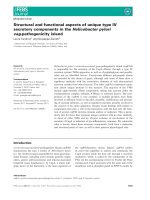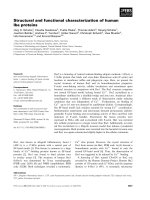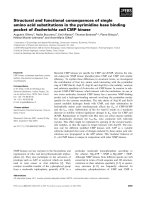Structural and functional studies of VP9, a novel nonstructural protein from white spot syndrome virus
Bạn đang xem bản rút gọn của tài liệu. Xem và tải ngay bản đầy đủ của tài liệu tại đây (3.28 MB, 148 trang )
STRUCTURAL AND FUNCTIONAL STUDIES OF VP9,
A NOVEL NONSTRUCTURAL PROTEIN FROM
WHITE SPOT SYNDROME VIRUS
LIU YANG
(B.Sc., Xiamen University)
A THESIS SUBMITTED FOR
THE DEGREE OF DOCTOR OF PHILOSOPHY
DEPARTMENT OF BIOLOGICAL SCIENCES
NATIONAL UNIVERSITY OF SINGAPORE
2007
ii
Dedicated to My Family
Table of Contents
Table of Contents
i
Acknowledgement
viii
Abstract
x
List of Figures
xi
List of Tables
xiii
List of Abbreviations
xiv
Chapter 1 Literature Review
1
1 Introduction
2
1.1 Introduction to virus
2
1.2 Introduction to crustacean virus
4
1.3 Introduction to WSSV
5
1.3.1 Background
5
1.3.2 Structural features of WSSV
6
1.3.3 Classification of WSSV
6
1.4 Research progress of WSSV
7
1.4.1 Sequence determination and analysis
7
1.4.2 Viral proteins identification
7
1.4.2.1 Latency-related genes identification
7
1.4.2.2 Immediate-early genes identification
9
i
1.4.2.3 Structural genes identification
10
1.4.2.4 Nonstructural genes identification
11
1.5 Introduction to methodology
14
1.5.1 Protein purification techniques
14
1.5.1.1 Affinity chromatography
14
1.5.1.2 Ion exchange chromatography
15
1.5.1.3 Size exclusion chromatography
15
1.5.2 Quantitative real-time RT-PCR
16
1.5.3 X-ray crystallography
17
1.5.4 NMR spectroscopy
21
1.6 Objectives of this project
26
Chapter 2 Materials and Methods
27
2.1 Materials
28
2.1.1 Enzyme and other proteins
28
2.1.2 Kit and reagents
28
2.1.3 Media
28
2.1.3.1 LB medium
28
2.1.3.2 M9 medium
29
2.1.4 Stock solutions and buffers
29
2.1.4.1 IPTG stock solution
29
2.1.4.2 Ampicillin stock solution
29
ii
2.1.4.3 Buffers for Ni-NTA purification under
native conditions
30
2.1.5 E.coli strains
2.1.6 Plasmid for protein expression
30
2.1.7 NMR chemicals and sample tube
30
2.2 Methods
31
2.2.1 Molecular biology techniques (DNA related)
31
2.2.1.1 PCR
31
2.2.1.2 Agarose gel electrophoresis
31
2.2.1.3 PCR products purification
31
2.2.1.4 Enzyme digestion, dephosphorylation
and purification
31
2.2.1.5 Ligation and transformation
32
2.2.1.6 Positive clone screening and plasmid
preparation
32
2.2.1.7 Cycle Sequencing Reaction
33
2.2.1.8 Sequence determination
33
2.2.1.9 Transformation
34
2.2.2 Protein manipulation techniques
34
2.2.2.1 Small scale test
34
2.2.2.2 Large scale production of recombinant
protein
35
iii
2.2.2.3 SDS-PAGE
35
2.2.2.4 Cell storage
36
2.2.2.5 Production of polyclonal antibodies
36
2.2.2.6 Western blot
36
2.2.2.7 Silver staining
37
Chapter 3 Characterization of VP9
38
3.1 Introduction
39
3.2 Materials and methods
39
3.2.1 Materials
39
3.2.2 Construction of the expression plasmid
41
3.2.3 Expression and purification of VP9
41
3.2.4 Mass spectrometry analysis
42
3.2.5 Dynamic light scattering study
42
3.2.6 Circular dichroism study
43
3.3 Results
43
3.3.1 Hydrophobicity plot
43
3.3.2 Protein purification profiles of VP9
43
3.3.3 Mass spectrometry analysis
44
3.3.4 Dynamic light scattering study
44
3.3.5 Circular dichroism study
44
3.4 Discussion
52
iv
Chapter 4 Functional Studies of VP9
53
4.1 Introduction
54
4.2 Materials and methods
55
4.2.1 Materials
55
4.2.2 Shrimp infection with WSSV
55
4.2.3 WSSV purification
55
4.2.4 Real-time RT-PCR
56
4.2.4.1 RNA extraction
56
4.2.4.2 Reverse transcription
57
4.2.4.3 Real-time PCR
57
4.2.5 Localization by Western blot
58
4.2.6 Localization by immuno-electron microscopy
59
4.2.7 Pull down assay
60
4.2.7.1 Bait protein preparation
60
4.2.7.2 Prey protein preparation
61
4.2.7.3 Pull down by Ni-NTA agarose beads
61
4.3 Results and discussions
62
4.3.1 Real-time RT-PCR
62
4.3.2 Localization
63
4.3.3 Pull down assay
63
v
Chapter 5 Structural Studies of VP9
75
5.1 Introduction
76
5.2 Materials and methods
76
5.2.1 Materials
76
5.2.2 X-ray studies
77
5.2.2.1 SeMet VP9 preparation
77
5.2.2.2 Crystallization
77
5.2.2.3 Data collection
77
5.2.3 NMR studies
78
5.2.3.1 Sample preparation
78
5.2.3.2 NMR experiments and data process
78
5.2.3.3 NMR relaxation studies
79
5.2.3.4 NMR metal titration
80
5.3 Results and discussions
80
5.3.1 X-ray studies
80
5.3.1.1 SeMet VP9 preparation
80
5.3.1.2 Crystallization
81
5.3.1.3 Data collection
81
5.3.1.4 Structure solution and refinement
82
5.3.1.5 Crystal structure of VP9
83
5.3.2 NMR studies
89
5.3.2.1 Sample preparation
89
vi
5.3.2.2 NMR structure
89
5.3.2.3 NMR relaxation studies
90
5.3.3 VP9 interacts with metals
95
5.3.3.1 Metal binding sites
95
5.3.3.2 NMR metal titration
99
5.3.4 Comparison of crystal structure vs. NMR
structure
101
5.3.5 Sequence and structural homology
101
5.3.6 Functional implications
104
Chapter 6 Summary and Future Studies
107
6.1 Summary
108
6.2 Future studies
109
6.2.1 Establishment of cell line
109
6.2.2 RNAi
109
6.2.3 Structural genomics
110
6.2.4 Structure-based drug design
112
Coordinates
114
References
115
Appendices 126
Publications 127
vii
Acknowledgements
I would like to thank all the people who contribute to this project.
In particular I am grateful to Professor Hew Choy Leong for giving me the
opportunity to pursue my PhD degree in the Department of Biological Sciences,
National University of Singapore.
My supervisor: Professor Hew Choy Leong to whom I am indebted for his
guidance, encouragement and support. My deepest gratitude to my co-supervisor:
Dr Sivaraman Jayaraman for his patience, guidance and trust. My special thanks to
Dr Song Jianxing for his help and support for my training in protein NMR.
I am grateful to my friends, Dr Lin Zhi and Dr Chen Zhaohua (Riken, JP) for
their valuable discussion and help on the NMR work; Dr Wu Mousheng (IMCB, SG)
for the technique guidance and discussion for protein crystallography study; Dr Fan
Jingsong for the NMR data collection; Dr Anand Saxena (Brook Haven Laboratory,
NY) for the help on protein crystal data collection; Dr Li Shaowei(Xiamen University,
China) for the help on the AUC experiment; Dr Song Wenjun, Dr Lin Qingsong, Dr Li
Zhengjun, Dr Asha, Dr Huang Canhua, Dr Wu Jinlu, Ms Tang Xuhua, Ms Sunita and,
Mr. Jobi and the rest of the lab mates for the valuable discussion and friendship and
the present and former members of Functional Genomics Laboratory as well as
Structural Biology Laboratory.
Special thanks to Lim Daina and Thomas Hegendoerfer (Munich, Germany) for
their contribution to the functional studies of VP9.
I would like to thank Professor Wong Sek Man and A/P Lin Tianwei (Scripps
Research Institute, USA) for the guidance on Cowpea Mosaic Virus project. Special
thanks go to Mr. Shashi Joshi for his help, advice and friendship.
My thanks also go to the service and facilities provided by the Protein and
Proteomic Center (PPC), Department of Biological Sciences, National University of
Singapore.
viii
My apologies to those whom I have not mentioned by name I am indebted to them
in many ways they had helped me.
I would like to pay tribute to my family whose love and support can never be
repaid.
Lastly, I would like to thank National University of Singapore for providing me
with research scholarship to pursue my PhD degree in NUS.
ix
Abstract
White Spot Syndrome Virus (WSSV) is a major pathogen in shrimp
aquaculture. VP9, a full
length protein of WSSV, encoded by ORF WSV230, was
identified for the first time, in the
infected Penaeus monodon shrimp tissues, gill and
stomach as a novel, nonstructural protein by
western blot, mass spectrometry and
immuno-electron microscopy. Real-time RT-PCR
demonstrated that the transcription
of VP9 started from the early to the late stage of WSSV
infection as a major mRNA
species. The structure of full length VP9 was determined by both X-ray and NMR
techniques. It represents the first structure to be reported for WSSV nonstructural
proteins. The crystal
structure of VP9 revealed a ferredoxin fold with divalent metal
ion binding sites. Cadmium
sulphate was found to be essential for crystallization. The
Cd
2+
ions were bound between the monomer interfaces of the homodimer. Various
divalent metal ions were titrated against VP9 and their interactions were analyzed
using NMR spectroscopy. The titration data indicated that VP9 binds with both Zn
2+
and Cd
2+
. VP9 adopts a similar fold as the DNA binding domain of the E2 protein
from human papillomavirus. Based on our present investigations, we hypothesize that
VP9 might be involved in the transcriptional regulation of WSSV, a function which is
similar to the E2 protein during papillomavirus infection of the host cells.
x
List of Figures
Figure 1.1 Electron micrographs of purified virions 12
Figure 1.2 Circular representation of the WSSV genome 13
Figure 3.1 VP9 amino acid sequence, WSSV and
expression vector information
40
Figure 3.2 Hydrophobicity plot of VP9 46
Figure 3.3 Purification profile of His-VP9 47
Figure 3.4 MS result of native VP9 48
Figure 3.5 DLS result of VP9 49
Figure 3.6 CD result of VP9 50
Figure 3.7 CD profiles upon pH changes 51
Figure 4.1 Transcriptional analysis of WSSV proteins by
Real-time RT-PCR
65
Figure 4.2 Localization analysis of VP9 by Western
Blotting and IEM
66
Figure 4.3 Confirmation of molecular weight of VP9 by
mass spectrometry
67
Figure 4.4 His-VP9 Bait protein purification profiles 71
Figure 4.5 12 % SDS-Page analysis (maxi-gel) of prey
capture (silver stain)
72
Figure 4.6 MS results for protein (band 1) 73
xi
Figure 4.7 MS results for protein (band 3) 74
Figure 5.1 Final purification profile of VP9 85
Figure 5.2 Crystals images of VP9 86
Figure 5.3 Ribbon diagram of crystal structure of VP9 88
Figure 5.4 SDS-PAGE of NMR samples 91
Figure 5.5 Ribbon diagram of NMR structures of VP9 92
Figure 5.6 NMR relaxation results 94
Figure 5.7 Simulated-annealing Fo-Fc omit map in the
dimerization region of VP9
97
Figure 5.8 Stick representation for the cadmium
coordination sphere
98
Figure 5.9 Dual
1
H-
15
N HSQC spectra of VP9 in the
absence and presence of Zn and Cd
100
Figure 5.10 Crystal structure vs. NMR mean structure 103
Figure 5.11 Proposed DNA binding model 106
xii
List of Tables
Table 1 Phasing methods in protein crystallography 19
Table 2 Programs and pro
g
ram packa
g
es commonl
y
used
in protein crystal structure determination
20
Table 3 2D and 3D NMR experimental methods and
their purposes
25
Table 4 Primer sequences for real-time RT-PCR 68
Table 5 Legend for prey protein samples 69
Table 6 Real-time RT-PCR analysis of vp9, vp28 and
dnapol from 0 to 72 h.p.i.
70
Table 7 Data collection and refinement statistics 87
Table
8 NMR structural statistics 93
xiii
List of Abbreviations
1D one-dimensional
2D two-dimensional
3D three-dimensional
Å Ångstrom (10
-10
m)
a.a. amino acid
ATPase adenosine triphosphatase
AUC analytical ultracentrifugation
bp base pair
B
0
magnetic field
BSA bovine serum albumin
CCP4 collaborative computational project No.4
CD Circular Dichroism
cDNA complementary DNA
CNS crystallography and NMR system
COSY correlation scpectroscopy
cryo-EM cryo-electron microscopy
δ chemical shift
Da Dalton (g mol
-1
)
DMSO dimethyl sulfoxide
DNase deoxyribonuclease
DNA deoxyribonucleic acid
dsDNA double-stranded DNA
Dicer dimer cleaves RNAi
DTT dithiothreitol
E.coli Escherichia coli
EDTA ethylenediamine tetraacetic acid
F
1
the acquired frequency dimension in an NMR spectrum
xiv
F
2
/F
3
indirectly detected frequency dimension in an NMR spectrum
HEPES 4-(2-hydroxyethyl)-1-piperazineethanesulfonic acid
HSQC heteronuclear single-quantum coherence
Hz hertz
HIV human immunodeficiency virus
IPTG isopropyl-β-D-thiogalactopyranoside
kbp kilo base pair
kDa kilo Dalton
LB Luria-broth medium
M mol l
-1
MAD multiple wavelength anomalous dispersion
MALDI matrix assisted laser desorption/ionization
Mbp mega-base pair
MCP major capsid protein
MIR multiple isomorphous replacement
ml milliliter
mM millimolar
mg milligram
MS mass spectrometry
ms millisecond
MW molecular weight
NCS non-crystallographic symmetry
ng nanogram
Ni-NTA nickel-nitrilotriacetic acid
nm nanometer
NMR nuclear magnetic resonance
NOE nuclear overhauser effect
NOESY nuclear overhauser effect spectroscopy
OD optical density
ORF open reading frame
xv
PAGE polyacrylamide gel electrophoresis
PCR polymerase chain reaction
pH potential of hydrogen
PMF peptide mass fingerprinting
PMSF Phenylmethylsulphonylfluoride
ppm parts per million
Q-TOF quadrupole-TOF
RISC RNA-induced silencing complex
RMSD root mean square deviation
RNAi RNA interference
RNase A ribonuclease A
S second
SAD Single-wavelength anomalous diffraction
SDS sodium dodecyl sulfate
Se Selenium
TEMED N,N,N’,N’-tetramethylethylendiamine
TOCSY total correlation spectroscopy
TOF time-of-flight
Tris tris (hydroxymethyl) aminomethane
µl microliter
µM micromolar
UV ultraviolet
Ala alanine
Arg arginine
Asn asparagines
Asp aspartic acid
Cys cysteine
Gln Glutamine
Glu glutamic acid
xvi
Gly glycine
His Histidine
Ile isoleucine
Leu leucine
Lys lysine
Met methionine
Phe phenylalanine
Pro proline
Ser serine
Thr threonine
Trp tryptophan
Tyr tyrosine
Val valine
xvii
1
Chapter 1 Literature Review
1
1 Introduction
White Spot Syndrome Virus (WSSV) is a major pathogen in shrimp
aquaculture, causing loss of billions of dollars every year. There is no effective
treatment for the WSSV infection up to date, thus leading to its prevention and
treatment being the utmost importance for this disease. The aim of this thesis is to
provide structural and functional insights into one of the nonstructural viral proteins
of this pathogen. This study would be valuable in understanding the critical roles such
as viral transcriptional and host-pathogen interactions. This information obtained will
thus provide the structural basis for the design of small molecule inhibitors as
potential drugs to against WSSV infection.
1.1 Introduction to virus
In 1898, Friedrich Loeffler and Paul Frosch found evidence that the causative
agent of foot-and-mouth disease in livestock was an infectious particle smaller than
any bacteria. This was the first clue to the nature of viruses, genetic entities that lie in
the grey area between living and non-living organisms.
Viruses depend on the host cells that they infect for reproduction. When
found outside of host cells, viruses exist as a protein coat or capsid that sometimes
enclosed within a membrane. The capsid encloses either DNA or RNA that codes for
viral elements. When a virus comes into contact with a host cell, it can inject its
genetic material into its host cells, taking over the host's replication machinery and
2
other cellular activities. An infected cell often produces more viral proteins and
genetic materials than its usual products. Some viruses can remain dormant inside
host cells for a long period of time, causing no obvious change in their host cells (a
stage known as the lysogenic phase). But when a dormant virus is stimulated, it can
enter the lytic phase where new viruses are formed, self-assembled, rupturing the host
cell and eventually killing the host cell before infecting other cells (Emiliani, 1993).
Viruses are ubiquitous and abundant in nature and can infect and parasitize
all living organisms from bacteria to mammals. They are considered to be simple
biological entities composed of a small number of macromolecules produced by, and
thus derived from, the organism they infect. There are more than 3000 families of
viruses. Viruses can differ greatly in their physical form. They can be round,
string-like, or can even resemble an elegant snow-crystal as does adenovirus. A
feature shared by all viruses is their highly compact structure. There is also a great
variability in the make up of their genome. Their genome can be RNA or DNA, single
or double stranded, positive or negative sense, monomeric or dimeric (or fragmented ),
naked or in complex with proteins. The genomes of two related viruses can
complement each other through structural, enzymatic and parasitic functions, thus
contributing to augment virus diversity. This notion of viral diversity by
trans-complementation within a virus population is important to our understanding of
viral dynamics and should always be kept in mind when studying single molecular
clones of a given virus or a part of it (Jean-Luc DARLIX et al., 2005).
The gene products of viruses generally are comprised of structural proteins
3
(SPs), which are the components of virus particles and nonstructural proteins (NPs),
which act as regulators or cofactors controlling the viral infection process.
1.2 Introduction to crustacean virus
The first report of a crustacean virus was in the crab Macropipus depurator
by Vago in 1966 (Vlak et al., 2004). Crustacean viruses are currently known to consist
of a wide range of viral families, including Baculoviridae, Birnaviridae, Bunyaviridae,
Herpesviridae, Piconaviridae, Parvoviridae, Reoviridae, Rhabdoviridae, Togaviridae,
Iridoviridae, Nodaviridae and Nimaviridae. Crustacean viral diseases listed by the
OIE (Office International Des Epizooties; the World Organization for Animal Health)
include Taura Syndrome (TS), White Spot Disease (WSD), Yellowhead Disease
(YHD), Tetrahedral Baculovirosis (Baculovirus penaei [BPV] infection), Spherical
Baculovirosis (Penaeus monodon-type baculovirus [MBV] infection), Infectious
Hypodermal and Haematopoietic necrosis (IHHN) and Infectious Myonecrosis (IMN).
Spawner-isolated Mortality Virus Disease (SMVD) was removed from the OIE
Aquatic Animal Health Code (2005) because the etiology is not well defined.
Infection with Mourilyan Virus (MoV), White Tail Disease (WTD), and
Hepatopancreatic Parvovirus (HPV) are listed as emerging diseases (Vlak et al.,
2004). As a crustacean virus, WSSV (Family: Nimaviridae, Genus: Whispovirus) is
very unique because its infection strategy does not match the infection models of any
other known virus (Lo, 2005).
4









